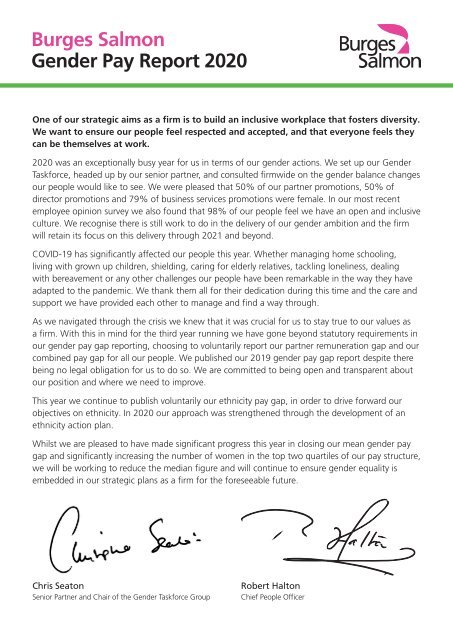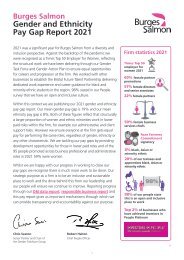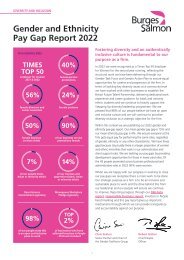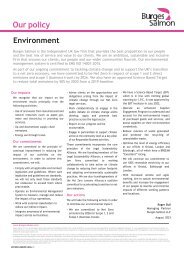Burges Salmon Gender Pay Gap Report 2020
You also want an ePaper? Increase the reach of your titles
YUMPU automatically turns print PDFs into web optimized ePapers that Google loves.
<strong>Burges</strong> <strong>Salmon</strong><br />
<strong>Gender</strong> <strong>Pay</strong> <strong>Report</strong> <strong>2020</strong><br />
One of our strategic aims as a firm is to build an inclusive workplace that fosters diversity.<br />
We want to ensure our people feel respected and accepted, and that everyone feels they<br />
can be themselves at work.<br />
<strong>2020</strong> was an exceptionally busy year for us in terms of our gender actions. We set up our <strong>Gender</strong><br />
Taskforce, headed up by our senior partner, and consulted firmwide on the gender balance changes<br />
our people would like to see. We were pleased that 50% of our partner promotions, 50% of<br />
director promotions and 79% of business services promotions were female. In our most recent<br />
employee opinion survey we also found that 98% of our people feel we have an open and inclusive<br />
culture. We recognise there is still work to do in the delivery of our gender ambition and the firm<br />
will retain its focus on this delivery through 2021 and beyond.<br />
COVID-19 has significantly affected our people this year. Whether managing home schooling,<br />
living with grown up children, shielding, caring for elderly relatives, tackling loneliness, dealing<br />
with bereavement or any other challenges our people have been remarkable in the way they have<br />
adapted to the pandemic. We thank them all for their dedication during this time and the care and<br />
support we have provided each other to manage and find a way through.<br />
As we navigated through the crisis we knew that it was crucial for us to stay true to our values as<br />
a firm. With this in mind for the third year running we have gone beyond statutory requirements in<br />
our gender pay gap reporting, choosing to voluntarily report our partner remuneration gap and our<br />
combined pay gap for all our people. We published our 2019 gender pay gap report despite there<br />
being no legal obligation for us to do so. We are committed to being open and transparent about<br />
our position and where we need to improve.<br />
This year we continue to publish voluntarily our ethnicity pay gap, in order to drive forward our<br />
objectives on ethnicity. In <strong>2020</strong> our approach was strengthened through the development of an<br />
ethnicity action plan.<br />
Whilst we are pleased to have made significant progress this year in closing our mean gender pay<br />
gap and significantly increasing the number of women in the top two quartiles of our pay structure,<br />
we will be working to reduce the median figure and will continue to ensure gender equality is<br />
embedded in our strategic plans as a firm for the foreseeable future.<br />
Chris Seaton<br />
Senior Partner and Chair of the <strong>Gender</strong> Taskforce Group<br />
Robert Halton<br />
Chief People Officer
Explaining the gender pay gap<br />
The gender pay gap measures the difference in hourly earnings between men and women within an<br />
organisation. It is important to note that this is different to equal pay, which focuses on women and<br />
men being paid the same for doing equal work.<br />
Organisations are required to report their:<br />
• mean and median gender pay gap;<br />
• distribution of men and women across the organisation divided into four quartiles from lowest to<br />
highest pay;<br />
• bonus gender pay gap;<br />
• proportion of men and women receiving a bonus.<br />
The data<br />
Employee gender pay gap<br />
<strong>2020</strong> 2019 2018 +/- change 2019-20<br />
Mean <strong>Gender</strong> <strong>Pay</strong><br />
<strong>Gap</strong><br />
17.9% 21.6% 21.9% -3.7%<br />
Median <strong>Gender</strong><br />
<strong>Pay</strong> <strong>Gap</strong><br />
32.6% 31.3% 33.3% +1.3%<br />
Proportion of men and women in each quartile<br />
of the pay structure<br />
Female<br />
Male<br />
Q1 (lower) Q2 (lower middle) Q3 (upper middle) Q4 (upper)<br />
22.8% (-3.33)<br />
77.2% (+3.33)<br />
26.7% (+1.9)<br />
73.3% (-1.9)<br />
40.1% ( -1.06)<br />
59.9% (+1.06)<br />
45.6% (-9.65)<br />
54.4% (+9.65)<br />
*+/- change 2019-20 in brackets
We ensure equal pay for men and women in the same roles. Our employee gender pay gap<br />
exists because of the higher percentage of women in our lower and lower middle pay quartiles<br />
– for example in our administrative and support roles. We are addressing this through a focus on<br />
progression opportunities for those in these lower pay quartiles. In <strong>2020</strong> we promoted a total of 33<br />
people across our business professional and legal support roles, 79% of whom were women.<br />
We are pleased to see our mean gender pay gap reducing year on year. The median figure<br />
has increased slightly in <strong>2020</strong> but is still below our 2018 figure. The median figure is sensitive<br />
to structural changes within the firm given that our workforce is 60% female. As we have<br />
reengineered our secretarial roles into a suite of new client support roles there have been new job<br />
opportunities which have mainly been filled by women. We are continuing to work to make these<br />
client support roles more attractive to men to even-out the gender balance in our lower and lower<br />
middle pay quartiles. It is very encouraging to see an increase in women in our upper middle and<br />
upper pay quartiles, with almost a 10% increase in women in the upper quartile.<br />
We have a good gender balance at senior levels amongst our people, with 64% of business<br />
professional leaders and 57% of directors and senior associates being female.<br />
Employee bonus gap<br />
<strong>2020</strong> 2019 2018 +/- change 2019-20<br />
Mean Bonus <strong>Gap</strong> 35.0% 34.0% 35.1% +1%<br />
Median Bonus <strong>Gap</strong> 7.1% 8.9% 11.2% -1.8%<br />
Proportion of men and women receiving a bonus<br />
(2019 figures shown in brackets)<br />
Men<br />
Women<br />
84% (79%) 82% (82%)<br />
We are pleased to see an almost equal proportion of men and women receiving bonuses at the<br />
firm, and this reflects equality in the number of men and women receiving high scores in our review<br />
processes and the structure of our firmwide scheme. The bonus gap is calculated using actual bonus<br />
amounts with no adjustments for part time working. Our bonuses are paid on a pro rata basis and<br />
significantly more of our women work part time than men, explaining the bonus gap that exists.
Partner remuneration gap<br />
<strong>2020</strong> 2019 2018 +/- change 2019-20<br />
Mean Partner<br />
Remuneration <strong>Gap</strong><br />
Median Partner<br />
Remuneration <strong>Gap</strong><br />
20.0% 22.0% 33.0% -2%<br />
29.0% 33.0% 33.0% -4%<br />
We do not have salaried partners at the firm. All of our partners are owners of our business and<br />
we operate a lockstep model which means that our partners’ remuneration is determined by the<br />
profits of the firm which are distributed equally dependent on their stage within the lockstep. We<br />
are pleased to report that our mean partner gap has reduced by 13% since 2018. This reduction<br />
represents the progression of an increasing number of female partners through the lockstep. There<br />
is no partner bonus gap because partners do not receive a bonus.<br />
Combined partner and employee pay / remuneration gap<br />
<strong>2020</strong> 2019 2018 +/- change 2019-20<br />
Mean Combined<br />
<strong>Pay</strong>/Remuneration<br />
<strong>Gap</strong><br />
Median Combined<br />
<strong>Pay</strong>/Remuneration<br />
<strong>Gap</strong><br />
60.0% 61.0% 63.0% -1%<br />
44.1% 47.0% 47.0% -2.9%<br />
Our combined pay/remuneration gap includes both employee and partner figures together. When we<br />
combine these two groups, our pay gap increases significantly due to the higher number of men in<br />
the partnership and the higher levels of remuneration received by partners. We will continue to focus<br />
our efforts to increase the number of women within the partnership.
Ethnicity pay gap and bonus gap<br />
<strong>2020</strong> 2019 2018 +/- change 2019-20<br />
Mean Ethnicity<br />
<strong>Pay</strong> <strong>Gap</strong><br />
Median Ethnicity<br />
<strong>Pay</strong> <strong>Gap</strong><br />
Mean Ethnicity<br />
Bonus <strong>Gap</strong><br />
Median Ethnicity<br />
Bonus <strong>Gap</strong><br />
-7.0% 3.2% 6.6% -10.2%<br />
-7.9% 10.4% 9.6% -18.3%<br />
24.0% 46.3% 14.5% -22.3%<br />
0% 0% 0% 0%<br />
We have voluntarily analysed and published our ethnicity pay gap for the third year as we feel it is<br />
important to understand the data and be transparent about this in order to help us develop a more<br />
diverse workforce.<br />
With 5% of our people classifying themselves as ethnically diverse, minor changes in workforce<br />
numbers can cause relatively large fluctuations in the ethnicity pay and bonus gap figures year on<br />
year. We are very pleased to see the ethnicity pay gap figures reducing to below zero and we will aim<br />
to keep this figure at around 0% where possible. Our mean ethnicity bonus gap has reduced from<br />
46% to 24% which is encouraging however there is still more work to be done in this area.<br />
What are we doing to address our pay gaps?<br />
<strong>Gender</strong><br />
We know from our statistics that we have a healthy workforce gender split across business services<br />
and on the legal side from trainee solicitor up to director level. However, there is less gender balance<br />
at partnership level, which is currently around 21% female, and within our client support teams (97%<br />
female). Our aim is for our proportion of partner promotions to reflect the gender ratios of our Senior<br />
Associates and Directors and we want to encourage more males to join our client support teams. We<br />
are closely monitoring our future talent pipeline to improve gender parity in future promotions.<br />
• In <strong>2020</strong>, 50% of our partner promotions were female and our highest ever proportion of<br />
women were appointed to director level (56%).<br />
• We know that we have work to do to improve gender balance within our partnership. We have<br />
established a <strong>Gender</strong> Taskforce who are delivering a 13 point gender action plan comprising<br />
initiatives that will support female talent into leadership. We recently launched our <strong>Gender</strong><br />
Balance Network ‘BBalanced’. Together these groups will play an important role in achieving our<br />
gender goals throughout the firm.
• We have expanded our Career Focus Training to improve transparency of career development<br />
opportunities for our people at all levels, equipping them with the necessary skills and knowledge<br />
to take ownership of their career.<br />
• We have improved support for our working parents and carers including coaching, establishing a<br />
parents and carers network and providing training for Partners on how to support members<br />
of their team who are parents. We have implemented a new family leave support framework<br />
to ensure our people receive the support they need before, during and after family leave. The<br />
framework includes improved communications, manager training, and both group and individual<br />
coaching sessions to help people return to work with confidence.<br />
• Family Matters is our parents and carers network which provides information, advice and<br />
support to working parents and carers. In <strong>2020</strong> we are increasing network activity, providing<br />
more opportunities for our people to collaboratively share experiences and practical ideas.<br />
• We have worked with the Law Society on their Women in Leadership in Law study and we<br />
have collaborated with Thomson Reuters as part of their Transforming Women’s Leadership<br />
in the Law programme, exploring factors that may be contributing to the loss of female talent in<br />
the legal sector and the steps needed to address this.<br />
• We are founder signatories of the Women in Business Charter which calls for businesses to<br />
commit to promoting gender equality in the workplace through seven goals, including promoting<br />
flexible and part-time working, increasing the number of women at senior levels and progression<br />
of lower paid and lower skilled female people.<br />
• All of our people complete regular mandatory Diversity and Inclusion training and we have<br />
delivered unconscious bias training to our board members, senior managers and partners.<br />
During 2021 we will be rolling this out more widely. We recognise that such training must be<br />
supported by inclusive practices and we are taking steps to review our policies and processes to<br />
minimise the impacts of unconscious bias.<br />
• We partner with the Womens Work Lab (WWL), a community collaboration that supports<br />
unemployed mums, aged 25+ and receiving benefits, to become work ready. The mums face<br />
challenges including domestic abuse, lone parenting and children with Special Educational Needs<br />
or home displacement. We provide funding to WWL and in <strong>2020</strong> provided a work placement for<br />
one of the mums, providing meaningful work experience in both our legal and business services<br />
side.<br />
Ethnicity<br />
Our aim is for our workforce to better reflect the communities in which we operate.<br />
• We are signatories of the Race at Work Charter and the Race Fairness Commitment<br />
illustrating our commitment to fairness at work for people of all ethnic backgrounds. There<br />
frameworks have supported the development of a diversity and inclusion focused Ethnicity<br />
Action Plan currently being delivered within the firm.<br />
• We use Rare Contextual Recruitment System for graduate and apprentice recruitment. This<br />
allows us to consider applicants’ achievements in the context in which those achievements were<br />
gained, taking into consideration several socioeconomic factors including postcode, school<br />
quality, and eligibility for free school meals. We have seen the benefits of Rare on the diversity of<br />
our trainee intakes, which are currently 22% BAME.
• In 2019 we implemented a blind recruitment policy for our apprentice and graduate<br />
recruitment, supporting our commitment to ensuring that our recruitment processes are fair and<br />
inclusive.<br />
• Our internal BAME network, BCultured, works alongside the firm’s diversity and inclusion group<br />
to inform, advise and advance BAME matters within <strong>Burges</strong> <strong>Salmon</strong>. The network has made<br />
a real difference to BAME inclusion both within the firm and in the wider community. They<br />
have engaged the wider firm, raining awareness through a fantastic programme of events and<br />
campaigns including Black History month and an allyship for anti-racism campaign. In addition,<br />
members have been central to the firm’s outreach work with schools and universities, providing<br />
access to positive role models and raising aspirations of young people. The network’s progress<br />
was recognised at the UK Legal Diversity Awards in November 2019, where they were shortlisted<br />
for ‘Outstanding BAME Network’.<br />
• We have supported Bristol City Council on the development of ‘Stepping Up’, a diversity<br />
leadership programme for future leaders in Bristol, developing a talent pipeline that more<br />
meaningfully reflects our population and community. We were recognised in the ‘Stepping Up<br />
Diversity Champion’ Award 2019 and <strong>2020</strong> for our support of the Stepping Up Programme.<br />
• Our trainee solicitors and apprentices come from a wide range of backgrounds; our current<br />
intakes are 22% BAME. We are apprenticeship ‘trailblazers’ and were involved in the<br />
development of the new legal apprenticeship standards, including the Level 7 qualification which<br />
allows individuals to qualify without having previously obtained a degree. We have taken on<br />
four legal apprentices each year since the launch of our programme in 2016 and expect our first<br />
cohort to qualify in 2023. We launched an apprenticeship scheme for business professionals in<br />
2019, which we expect to open up other professional careers within the firm.<br />
The data published in this report is published by <strong>Burges</strong> <strong>Salmon</strong> Company Limited (BSCL), a wholly owned subsidiary and the service<br />
company of <strong>Burges</strong> <strong>Salmon</strong> LLP. BSCL is the main employing entity for <strong>Burges</strong> <strong>Salmon</strong>’s employees. © <strong>Burges</strong> <strong>Salmon</strong> LLP 2021








